Here is a brief study guide containing all the concepts covered in the Secondary 4 CST mathematics pathway. To explain everything, each formula will be followed by an example and a link to a concept sheet in our virtual library.
||y = ax + b||
where
||a = \dfrac{\Delta y}{\Delta x} = \dfrac{y_2 - y_1}{x_2 - x_1}||
With the information provided in the graph below, determine the line’s equation in function (standard) form.
-
Find the slope using |\dfrac{\Delta y}{\Delta x}.|
-
Find the initial value |(b)| by substituting in one of the points of the graph. ||\begin{align} f(x) &= 2{.}4x+b \\ 2 &= 2{.}4(-0{.}5)+b \\ b &=3{.}2 \end{align}||
Answer: The equation of the line in function form is |y=2{.}4x+3{.}2.|
See also
||y = ax^2||where the value of |a| is determined by substituting a known point.
With the information provided in the graph below, determine the equation of the parabola.
|
CALCULATIONS |
EXPLANATIONS |
|---|---|
|
|\begin{align} \color{blue}{f(x)} &= a \color{green}{x}^2 \\ \color{blue}{-6{.}75} &= a \color{green}{(-1{.}5)}^2 \\ -3 &= a \end{align}| |
Substitute the values of |x| and |y| with a point of the curve to find the value of |a|. |
|
The equation of the parabola is |f(x) = -3 x^2|. |
|
For a second-degree polynomial function, |a \ne \dfrac{\Delta y}{\Delta x}.|
||y = a(c)^x|| where
|a|: Initial value
|c|: Base (multiplying factor)
In 2005, there were 500 toads in a pond. The population is decreasing by 5% each year. If the population continues to decline at this pace, in what year will there be approximately 368 toads?
| CALCULATIONS | EXPLANATIONS |
|---|---|
| |x:| Number of years elapsed since 2005 |f(x):| Number of toads | Define the variables. |
| |\begin{align} f(x) &= a (c)^{x} \\ f(x) &= 500 (c)^{x} \end{align}| | Replace |a| by the initial value, i.e., the number of toads in 2005. |
| |\begin{align} f(x) &= 500 (c)^{x} \\ f(x) &= 500 (0{.}95)^{x} \end{align}| | Replace |c| with |0{.}95,| since |c = 1 - 5\ \% = 1 - 0{.}05 = 0{.}95.| |
| |\begin{align} f(6) &= 500 (0{.}95)^{6} \\ f(6) &\approx 368 \end{align}| | By replacing |x| with different values and using trial-and-error, we deduce that |x=6.| |
| If |x=6,| then in |6| years there will be |368| toads. Since the study took place in 2005, we can deduce that in 2011 (2005 + 6) there will be approximately |368| toads. | |
See also
In this type of graph, the solid (closed) points (|\bullet|) represent datas that are included, while empty (open) points (|\circ|) represent datas that are not included.
When the Videotron Centre opened in the city of Quebec, all Quebecers could purchase tickets to visit. In theory, the visit lasted two hours, but visitors had the option of leaving after one hour. This situation can be modelled according to the following graph:

According to the graph above, how many Quebecers were visiting the Videotron Centre at 6 p.m.?
|
CALCULATIONS |
EXPLANATIONS |
|---|---|
| |
Identify 6 p.m. on the |x|-axis. |
| |
Select the solid point which is included in the function at that moment and mark its height on the |y|-axis. |
|
According to the graph, there were 7 000 people visiting the Videotron Centre at 6 p.m.. |
|
See also
In a periodic function, a cycle is a repeating pattern, while the period is the length of one cycle along the |x|-axis.
Marie-Claude decides to get back in shape after a vacation by cycling with her group of friends. A coach travels with the group, guiding them and deciding what speed to maintain. The trainer gives the following graph to each group member to prepare them for the next session:

The training consists of repeating the same route for 45 minutes. By the end of her training, how many minutes, in total, will Marie-Claude have pedaled at a minimum speed of 16 km/h?
|
CALCULATIONS |
EXPLANATIONS |
|---|---|
| |
Identify the places where the speed is 16 km/h on the first cycle. |
| |
Identify the points on each of the lines where the desired minimum speed is located. |
|
|a = \dfrac{\Delta y}{\Delta x} = \dfrac{24-12}{4-3} = 12| |
Find the equation of |\color{green}{\text{the green line}}.| To do so, use the points |(3,12)| and |(4,24)|, since they are on |\color{green}{\text{the green line}}.| |
|
|\begin{align} 16 &= 12x - 24 \\ 40 &= 12x \\ \color{green}{3{.}33} &\approx x \end{align}| |
Replace |y|with |16| to find the time, in minutes, of the |\color{green}{\text{green point}}.| |
|
|a = \dfrac{\Delta y}{\Delta x} = \dfrac{24-0}{4-6} = -12| So, |y = -12x + b| Finally, |\color{blue}{y=-12x + 72}| |
Find the equation of |\color{blue}{\text{the blue line}}.| To do so, use the points |(4,24)| and |(6,0)|, since they are on |\color{blue}{\text{the blue line}}.| |
|
|\begin{align} 16 &= -12x + 72 \\ -56 &= -12x \\ \color{blue}{4{.}67} &\approx x\end{align}| |
Replace |y| with |16| to find the time, in minutes, of the |\color{blue}{\text{blue point}}.| |
|
|\color{blue}{4{.}67} - \color{green}{3{.}33} = \color{red}{1{.}34 \ \text{min}}| |
Determine the duration between |\color{green}{\text{the green point}}| and |\color{blue}{\text{the blue point}}.| |
|
|6 - 0 = 6 \ \text{min}| |
Determine the period (length) of the repeated cycle. |
|
|\begin{align} \text{No. of cycles} &= \dfrac{\text{Total trip duration}} {\text{Duration of One Cycle}} \\ \text{No. of cycles} &= \dfrac{45}{6} \\ \text{No. of cycles} &=7{.}5 \end{align}| |
Determine the number of complete cycles in the route. |
|
|7{.}5| equals |7| complete cycles |(7 \times 6 = 42\ \text{min})| and another half a cycle.
So, the |1{.}34| minute interval repeats exactly seven times. |
Analyze the incomplete cycle to determine if the portion meets the requirements of the initial question (minimum speed of 16 km / h). |
|
|\begin{align} \text{Total duration} &= \color{red}{\text{Duration of One Cycle}} \times \text{No. of periods} \\ \text{Total duration} &= \color{red}{1{.}34} \times 7 \\ \text{Total duration} &= 9{.}38 \end{align}| |
Determine the total duration of the analyzed interval. |
|
By the end of her training, Marie-Claude will have spent a total of |9{.}38| minutes pedaling at a speed of at least 16 km / h. |
|
See also
The same properties must be analyzed each time a function is studied:
-
the domain: all possible |x| values
-
the range: all possible |y| values
-
the x-intercept: the value of |x| when |y=0|
-
the y-intercept: the value of |y| when |x=0|
-
maximum: the greatest value of |y|
-
minimum: the smallest value of |y|
-
increase: when the graph "goes upwards" or is constant
-
decrease: when the graph "goes downwards" or is constant
-
positive sign: interval of x of the graph that is above or equal to the |x|-axis
-
negative sign: interval of x of the graph that is below or equal to the |x|-axis
As an accountant of a large company, you must give a detailed account of the trends in profits over the past year. To help, here is a graph of the last 12 months.

To properly defend your argument, you must complete a full study of the graph before preparing your presentation speech.
|
PROPERTIES |
EXPLANATIONS |
|---|---|
|
Domain: |[0, 12]| |
The smallest value on the |x|-axis is |0| and the largest is |12.| |
|
Range: |[-5, 20]| |
The smallest value on the |y|-axis is |-5| and the largest is |20.| |
|
Increase: |[0, 4] \cup [9, 12]| |
When analyzing the |x| values, these two portions of the graph go up or remain constant. |
|
Decrease: |[4, 10]| |
When analyzing the |x| values, this is the only portion of the graph that goes down or remains constant. |
|
Maximum: |\left\{20 \right\}| |
Among the |y| values, this is the largest value reached by the graph. |
|
Minimum: |\left\{-5\right\}| |
Among the |y| values, this is the smallest value reached by the graph. |
|
Zeros of the Function: |(0,0), (8,0), (11,0)| |
These are the coordinates of the points where the graph intercepts the |x|-axis. |
|
Y-intercept: |(0,0)| |
It is the coordinate of the point where the graph intercepts the |y|-axis. |
|
Positive: | [0,8] \cup [11,12]| |
Among the |x| values, these portions of the graph are above or equal to the |x|-axis. |
See also
Follow these steps to solve a system of equations using comparison:
-
Identify the variables associated with the unknowns.
-
Create the equations according to the situation.
-
Isolate the same variable in each equation.
-
Compare the two equations to form a new one.
-
Solve this new equation.
-
Substitute the found variable’s value into one of the starting equations to find the value of the other.
At a corner store, a group of workers buys 4 coffees and 6 muffins for |$15{.}06.\ |The next day, this same group buys 3 coffees and 5 muffins for |$11{.}97.\ |If the following day they want to buy 6 coffees and 4 muffins, how much will it cost?
-
Identify each unknown using variables
|x=| cost of a coffee |($)|
|y=| cost of a muffin |($)| -
Create a system of equations
||\color{blue}{4x + 6y = 15{.}06}\\ \color{red}{3x + 5y = 11{.}97}|| -
Convert each equation into function form
||\begin{align} y &= \color{blue}{2{.}51 - \dfrac{4}{6}x} \\ y &= \color{red}{2{.}394 - \dfrac{3}{5}x} \end{align}|| -
Compare the two equations
||\color{blue}{2.51 - \dfrac{4}{6}x} = \color{red}{2.394 -\dfrac{3}{5}x}|| -
Find the value of |x| by isolating it using the inverse operations
||\begin{align} \color{blue}{2{.}51 - \dfrac{4}{6}x} &= \color{red}{2{.}394 - \dfrac{3}{5}x} \\ 2{.}51 - 2{.}394 &= -\dfrac{3}{5}x + \dfrac{4}{6}x \\ 0{.}116 &= \dfrac{1}{15}x \\ 1{.}74 &= x \end{align}|| -
Substitute this value of |x| into one of the two starting equations to find the value of |y|
||\begin{align} 4x + 6y &= 15{.}06 \\ 4 (1{.}74) + 6y &= 15{.}06 \\ y &= 1{.}35 \end{align}|| -
Calculate the cost of |6| coffees and |4| muffins
||\begin{align} 6 \ \text{coffees} + 4\ \text{muffins} &=\ ? \\ 6x + 4y &=\ ? \\ 6 (1{.}74) + 4 (1{.}35) &=\ ? \\ 15{.}84 &=\ ? \end{align}||
Answer: It will cost |$15{.}84.\ |
See also
We can follow these steps to solve a system of equations using substitution:
-
Identify the variables associated with the unknowns.
-
Create the equations according to the situation.
-
Isolate a variable in one of the two equations.
-
Substitute this same variable in the other equation with the algebraic expression associated with it.
-
Solve this new equation.
-
Substitute the found variable’s value into one of the starting equations to find the value of the other variable.
At a corner store, a group of workers buys 4 coffees and 6 muffins for |$15{.}06.\ |The next day, this same group buys 3 coffees and 5 muffins for |$11{.}97.\ |How much will it cost if they want to buy 6 coffees and 4 muffins the day after that?
-
Identify the unknowns using variables
|x=| cost of a coffee |($)|
|y=| cost of a muffin |($)| -
Create a system of equations ||\color{blue}{4x + 6y = 15{.}06}\\ \color{red}{3x + 5y = 11{.}97}||
-
Convert one of the two equations into function form||\begin{align} \color{blue}{4x + 6y} &= \color{blue}{15{.}06} \\ \color{blue}{y} &= \color{blue}{2{.}51 - \dfrac{4}{6}x} \end{align}||
-
Substitute the |y| into the other equation with its associated algebraic expression ||\begin{align} \color{red}{3x + 5}\color{blue}{y} &= \color{red}{11{.}97} \\ \color{red}{3x + 5} \color{blue}{\left(2{.}51 - \dfrac{4}{6}x \right)} &= \color{red}{11{.}97} \end{align}||
-
Find the value of |x| by isolating it using the inverse operations ||\begin{align} \color{red}{3x + 5} \color{blue}{\left(2{.}51 - \frac{4}{6}x\right)} &= \color{red}{11{.}97} \\ 3x + 12{.}55 - \frac{20}{6}x &= 11{.}97 \\ x &= 1{.}74 \end{align}||
-
Substitute the value of |x| into one of the two starting equations to find the value of |y| ||\begin{align} 4x + 6y &= 15{.}06 \\ 4 (1{.}74) + 6y &= 15{.}06 \\ y &= 1{.}35 \end{align}||
-
Calculate the amount for |6| coffees and |4| muffins ||\begin{align} 6 \ \text{coffees} + 4\ \text{muffins} &=\ ? \\ 6x + 4y &=\ ? \\ 6 (1{.}74) + 4 (1{.}35) &=\ ? \\ 15{.}84 &=\ ? \end{align}||
Answer : It will cost |$15{.}84.\ |
See also
We can follow these steps to solve a system of equations through elimination:
-
Identify the variables associated with the unknowns.
-
Create the equations according to the situation.
-
Find equivalent equations to obtain the same coefficient for the same variable.
-
Subtract the two equations.
-
Isolate the remaining variable to find its value.
-
Substitute the found value of this variable into one of the starting equations to find the value of the other variable.
At a corner store, a group of workers buys 4 coffees and 6 muffins for |$15{.}06.\ |The next day, the same group buys 3 coffees and 5 muffins for |$11{.}97.\ |How much will it cost if they want to buy 6 coffees and 4 muffins the day after that?
-
Identify the unknowns using variables
|x=| cost of a coffee |($)|
|y=| cost of a muffin |($)| -
Create a system of equations ||\color{blue}{4x + 6y = 15{.}06}\\ \color{red}{3x + 5y = 11{.}97}||
-
Find equivalent equations to obtain the same coefficient for |x| in each of the equations ||\begin{align} 3\big( \color{blue}{4x + 6y} = \color{blue}{15{.}06}\big) &\Rightarrow \color{blue}{12x + 18y = 45{.}18} \\ 4 \big(\color{red}{3x + 5y} = \color{red}{11{.}97}\big) &\Rightarrow \color{red}{12x + 20y = 47{.}88} \end{align}||
-
Using subtraction, complete the elimination of each of the like terms ||\begin{align} \color{blue}{12x + 18y} &= \color{blue}{45{.}18} \\ -\big(\color{red}{12x + 20y} &= \color{blue}{47{.}88}\big)\\ \hline -2y &=-2{.}70 \end{align}||
-
Find the value of |y| by isolating it using the inverse operations ||\begin{align} -2y &=-2{.}70 \\ y &= 1{.}35 \end{align}||
-
Substitute the found value of |y| into one of the two starting equations to find the value of |x| ||\begin{align} 4x+6y &= 15{.}06 \\ 4x+6(1{.}35) &=15{.}06 \\ x &= 1{.}74 \end{align}||
-
Calculate the amount for |6| coffees and |4| muffins||\begin{align} 6 \ \text{coffees} + 4\ \text{muffins} &=\ ? \\ 6x + 4y &=\ ? \\ 6 (1{.}74) + 4 (1{.}35) &=\ ? \\ 15{.}84 &=\ ? \end{align}||
Answer: It will cost |$15{.}84.\ |
See also
We can deduce three theorems from the following right-angled triangle.
-
The measure of each side of the right angle in a right triangle is the geometric mean between its projection onto the hypotenuse and the hypotenuse itself. ||\begin{align} \dfrac{m}{a} = \dfrac{a}{c}\ &\Leftrightarrow\ a^2 = m c \\\\ \dfrac{n}{b} = \dfrac{b}{c}\ &\Leftrightarrow\ b^2 = n c \end{align}||
-
In a right triangle, the measure of the height from the vertex of the right angle (altitude) is the geometric mean of the projections of the sides onto the hypotenuse. ||\dfrac{m}{h} = \dfrac{h}{n}\ \Leftrightarrow\ h^2 = m n||
-
The product of the measures of the hypotenuse and the height (altitude) in a right triangle equals the product of the measures of the sides of the right angle. ||c h = a b||
To stand out from other contractors, a construction company suggests houses with roofs of different shapes. The following form is among these choices:

An entrepreneur needs the two missing outer measurements of this triangle |(\overline {AB}, \overline {BC})| to estimate production costs. Help him find them.
|
CALCULATIONS |
EXPLANATIONS |
|---|---|
|
|\begin{align} &a\; = 6{.}5 \\ &m = 4{.}1 \\ &c \ (m\overline {AB}) =\ ? \\ &b \ (m\overline {BC}) =\ ? \end{align}| |
Associate all known and desired measurements with one of the measurements in the reference drawing. |
|
|\begin{align} a^2 &= m c \\ 6{.}5^2 &= 4{.}1 c \end{align}| |
Choose the theorem where there will be only one unknown: In a right angle triangle, the measure of each side of the right angle is the geometric mean between its projection onto the hypotenuse and the hypotenuse itself. |
|
|\begin{align} 6{.}5^2 &= 4{.}1 c \\ 42{.}25 &= 4{.}1 c \\ \dfrac{42{.}25}{\color{red}{4{.}1}} &= \dfrac{4{.}1c}{\color{red}{4{.}1}} \\ 10{.}3 &\approx c \end{align}| |
Solve the equation. |
|
|\begin{align} a^2 + b^2 &= c^2 \\ 6{.}5^2 + m\overline {BC}^2 &= 10{.}3^2 \\ 42{.}25 + m\overline {BC}^2 &\approx 106{.}09 \\ m\overline {BC}^2 &\approx 63{.}84 \\ m\overline {BC} &\approx 8 \end{align}| |
Apply the Pythagorean theorem on the large green right triangle to find the measure of the missing leg. |
|
So, |m \overline {AB} \approx 10{.}3 \ \text{m}| and |m \overline {BC} \approx 8 \ \text{m}.| |
|
Considering the angle |\theta| as a reference, we get:
|\sin \theta = \dfrac{\text{Measure of the side opposite to }\ \theta}{\text{Measure of the hypotenuse}}|
|\cos \theta = \dfrac{\text{Measure of the side adjacent to }\ \theta}{\text{Measure of the hypotenuse}}|
|\tan \theta = \dfrac{\text{Measure of the side opposite to } \ \theta}{\text{Measure of the side adjacent to } \ \theta}|
The elevation angle of a house's roof trusses must be a minimum of |25^\circ| for building standards to be met. To ensure this constraint is respected, a manufacturer decides to make this angle |35^\circ.| If we know that the length of the roof truss is 13 metres, what will be the measurements of the other two sides?
|
CALCULATIONS |
EXPLANATIONS |
|---|---|
|
|\sin \color{red}{35^\circ} = \dfrac{\color{red}{c}}{\color{green}{13}}| |
Identify the appropriate trigonometric ratio: |\sin \theta = \dfrac{\text{Opposite}}{\text{Hypotenuse}}| |
|
|\begin{align} \sin \color{red}{35^\circ} &= \dfrac{\color{red}{c}}{\color{green}{13}} \\ \color{green}{13}\sin \color{red}{35^\circ} &= \color{red}{c} \\ 7{.}46 &\approx \color{red}{c} \end{align}| |
Solve the equation. |
|
|\cos \color{red}{35^\circ} = \dfrac{\color{blue}{b}}{\color{green}{13}}| |
Identify the correct trigonometric ratio: |\cos \theta = \dfrac{\text{Adjacent}}{\text{Hypotenuse}}| |
|
|\begin{align} \cos \color{red}{35^\circ} &= \dfrac{\color{blue}{b}}{\color{green}{13}} \\ \color{green}{13} \cos \color{red}{35^\circ} &= \color{blue}{b} \\ 10{.}65 &\approx \color{blue}{b} \end{align}| |
Solve the equation. |
|
So, |\color{blue}{m \overline {AC}} \approx 10{.}65 \ \text{m}| and |\color{red}{m \overline {AB}} \approx 7{.}46 \ \text{m}.| |
|
To determine a helicopter’s route to rescue people in distress in the forest, a map of the region has been triangulated with the current location of the helicopter, the hospital, and the people who need help.
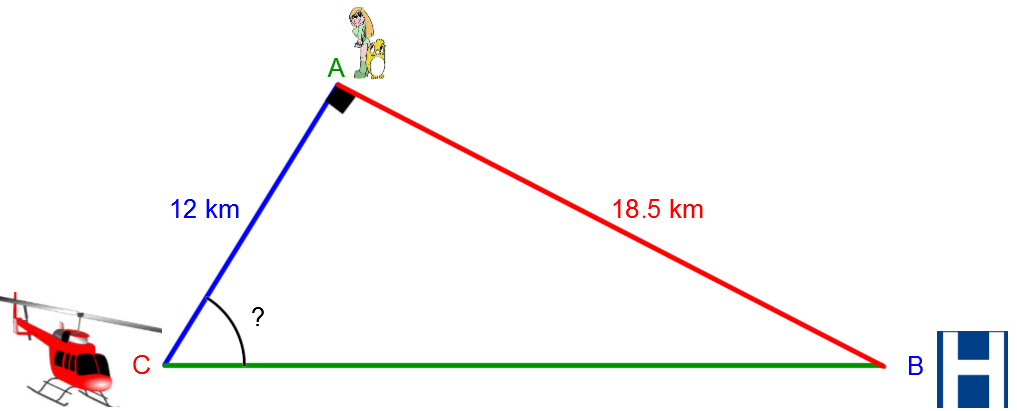
According to this drawing, what angle of orientation should the helicopter use to reach the people in distress as quickly as possible?
|
CALCULATIONS |
EXPLANATIONS |
|---|---|
|
|\tan ? = \dfrac{\color{red}{18{.}5}}{\color{blue}{12}}| |
Identify the correct trigonometric ratio: |\tan \theta = \dfrac{\text{Opposite}}{\text{Adjacent}}| |
|
|\begin{align} \tan ? &= \dfrac{\color{red}{18{.}5}}{\color{blue}{12}} \\ \tan ? &\approx 1{.}54 \\ ? &= \tan^{-1}(1{.}54) \\ ? &\approx 57^\circ \end{align}| |
Solve the equation. |
|
The helicopter's orientation angle should be |57^\circ.| |
|
See also
It is possible to deduce a series of equivalences for any given triangle.
|\dfrac{a}{\sin A} = \dfrac{b}{\sin B} = \dfrac{c}{\sin C}|
At some Western events, horse races are organized to liven up the show. During these races, cowboys must ride around each of three barrels, which are arranged in the shape of an isosceles triangle.
With the measurements given, what is the distance between each barrel?
|
CALCULATIONS |
EXPLANATIONS |
|---|---|
| |
Identify the vertices and edges of the triangle. |
| |
If possible, deduce the other measurements of the triangle (using the sum of interior angles of a triangle and the properties of the isosceles triangle). |
|
|\begin{align} \dfrac{\color{green}{a}}{\sin 40^\circ} &= \displaystyle \dfrac{\color{blue}{20}}{\sin \color{blue}{70^\circ}} \\\\ \Rightarrow\ \color{green}{a} &= \dfrac {\color{blue}{20} \sin 40^\circ}{\sin \color{blue}{70^\circ}} \\ \color{green}{a} &\approx 13{.}68 \ \text{m} \end{align}| |
Apply the law of sines and isolate the variable. |
|
So, |m \overline{AB} = m \overline {AC} = 20 \ \text{m}| and |m \overline {BC} \approx 13{.}68 \ \text{m}| |
|
To maximize aerodynamics, the shape of some race cars resembles a triangle.

What should the measurement of the angle near the rear wheel be to maintain these proportions?
|
CALCULATIONS |
EXPLANATIONS |
|---|---|
 |
Identify the vertices and edges of the triangle. |
|
|\begin{align} \dfrac{\color{blue}{1{.}18}}{\sin \color{blue}{15}} &= \dfrac {\color{red}{3{.}39}}{\sin \color{red}{B}} \\\\ \Rightarrow\ \sin \color{red}{B} &= \dfrac{\color{red}{3{.}39} \sin \color{blue}{15}}{\color{blue}{1{.}18}} \\ \sin \color{red}{B} &\approx 0{.}744 \end{align}| |
Use the law of sines and isolate the sine of the desired angle. |
|
|\begin{align} \sin \color{red}{B} &\approx 0{.}744 \\ \color{red}{ B} &\approx \sin^{-1} (0{.}744) \\ \color{red}{B} &\approx 48{.}1^\circ \end{align}| |
Calculate the value of the variable by using |\sin^{-1}.| |
|
|\begin{align} \color{red}{m\angle B} &\approx 180^\circ - 48{.}1^\circ \\ \color{red}{m\angle B} &\approx 131{.}9^\circ \end{align}| |
Find the value of the obtuse angle. |
|
The measure of the angle is |131{.}9^\circ.| |
|
When identifying the triangle, it is essential to identify:
-
|\color{green}{\text{side a opposite to angle A}}|
-
|\color{red}{\text{side b opposite to angle B}}|
-
|\color{blue}{\text{side c opposite to angle C}}|
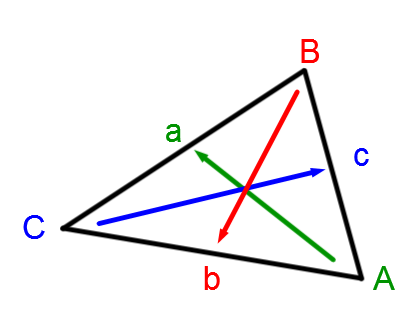
See also
We can calculate the area of any triangle using the formula below.
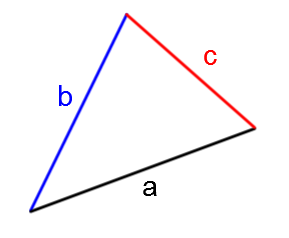
|\text{Area}=\sqrt{p(p - a)(p - \color{blue}{b})(p - \color{red}{c})}|
where
|p=\dfrac{a + \color{blue}{b} + \color{red}{c}}{2}|
To ensure its security, a bank wants to calculate the area of its floor that is covered by surveillance camera.

Determine the area of this space using the information provided above.
|
CALCULATIONS |
EXPLANATIONS |
|---|---|
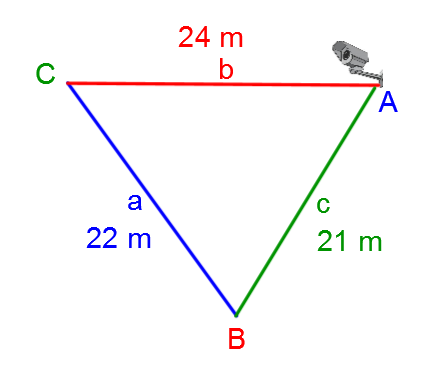 |
Identify the vertices and edges of the triangle. |
|
|\begin{align} p &= \dfrac{\color{blue}{a}+\color{red}{b}+\color{green}{c}}{2} \\ &= \dfrac{\color{blue}{22}+\color{red}{24}+\color{green}{21}}{2} \\ &= 33{.}5\ \text{m} \end{align}| |
Calculate the value of the half-perimeter |(p)| of the figure. |
|
|\begin{align} A &=\sqrt{p(p-\color{blue}{a})(p-\color{red}{b})(p-\color{green}{c})}\\ &=\sqrt{33{.}5(33{.}5-\color{blue}{22})(33{.}5-\color{red}{24})(33{.}5-\color{green}{21})} \end{align}| |
Substitute the values into the formula to calculate the area of the triangle. |
|
|\begin{align} A &=\sqrt{33{.}5(33{.}5-\color{blue}{22})(33{.}5-\color{red}{24})(33{,}5-\color{green}{21})} \\ &= \sqrt{33{.}5(11{.}5)(9{.}5)(12{.}5)} \\ &\approx 213{.}89\ \text{m}^2 \end{align}| |
Solve the equation while respecting the order of operations. |
|
The area of the floor that is covered by surveillance camera is |213{.}89\ \text{m}^2.| |
|
See also
-
A - S - A: Two triangles are isometric when a pair of corresponding congruent sides is located between two pairs of corresponding congruent angles.
-
S - A - S: Two triangles are isometric when a pair of corresponding congruent angles is located between two pairs of corresponding congruent sides.
-
S - S - S: Two triangles are isometric when all pairs of corresponding sides are congruent.
Due to machinery problems, employees at a construction company must assemble the triangular-shaped roof trusses themselves to complete the construction of a house. However, they must make sure that all of the trusses are identical.

Using the information provided above, demonstrate that these two constructions are congruent.
|
STATEMENTS |
JUSTIFICATIONS |
|---|---|
|
|\angle \color{red}{BAC} \cong \angle \color{green}{EFG}| |
|m \angle \color{green}{EFG} = 180^\circ - 130^\circ - 17^\circ = 33^\circ = m \angle \color{red}{BAC}| |
|
|\color{red}{\overline{AB}} \cong \color{green}{\overline{EF}}| |
By hypothesis |
|
|\angle \color{red}{ABC} \cong \angle \color{green}{DEF}| |
By hypothesis |
|
|\Delta \color{red}{ABC} \cong \Delta \color{green}{DEF}| by A-S-A |
|
-
A - A: Two triangles are similar when two pairs of corresponding angles are congruent.
-
S - A - S: Two triangles are similar when a pair of corresponding congruent angles is located between two pairs of proportional corresponding sides.
-
S - S - S: Two triangles are similar if all three pairs of corresponding sides are proportional.
The city is organizing a family run as part of a fundraiser for a community group. They want the path taken by the adults to be similar to the one taken by the children.

Demonstrate that the two paths are similar using the information provided above.
|
STATEMENTS |
JUSTIFICATIONS |
|---|---|
|
|\dfrac{m\color{green}{\overline{AC}}}{m \color{blue}{\overline {DF}}} = \dfrac{m\color{green}{\overline{AB}}}{m \color{blue}{\overline {DE}}}= \dfrac{m\color{green}{\overline{BC}}}{m \color{blue}{\overline {EF}}}| |
|\begin{align} \dfrac{\color{green}{1{.}4}}{\color{blue}{3{.}5}} &= \dfrac{\color{green}{1{.}1}}{\color{blue}{2{.}75}}= \dfrac{\color{green}{0{.}8}}{\color{blue}{2}} \\ \dfrac{2}{5}\ \ &=\ \ \dfrac{2}{5}\ \ \ =\ \ \dfrac{2}{5}\end{align}| |
|
Therefore, |\Delta \color{green}{ABC} \sim \Delta \color{blue}{DEF}| by S-S-S. |
|
|\text{Distance} = \sqrt{(y_2 - y_1)^2 + (x_2 - x_1)^2}|
where
|(x_1, y_1):| Coordinates of the starting point of the segment
|(x_2, y_2):| Coordinates of the ending point of the segment
To determine the amount of gasoline that an airplane must have in its tank to complete a Montreal-Paris flight, both cities are represented on a Cartesian plane (graduated in kilometres).
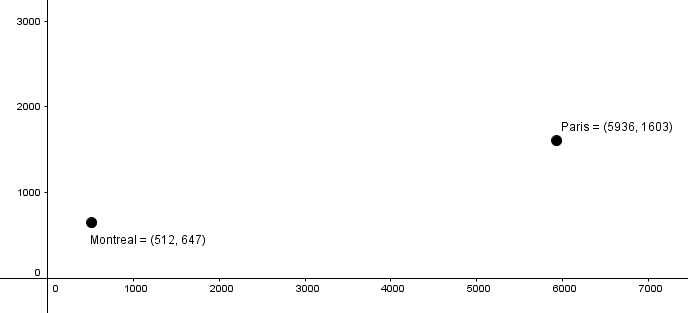
What is the distance, in kilometres, between these two cities?
|
CALCULATIONS |
EXPLANATIONS |
|---|---|
|
Montreal |= (\color{blue}{x_1}, \color{red}{y_1}) = (\color{blue}{512}, \color{red}{647})| |
Identify the points |(x_1, y_1)| and |(x_2, y_2).| |
|
|\begin{align} \text{Distance} &= \sqrt{(y_2 - \color{red}{y_1})^2 + (\color{green}{x_2} - \color{blue}{x_1})^2} \\ \text{Distance} &= \sqrt{(1\ 603 - \color{red}{647})^2 + (\color{green}{5\ 936} - \color{blue}{512})^2} \end{align}| |
Substitute the values into the formula. |
|
|\begin{align} \text{Distance} &= \sqrt{(1\ 603 - \color{red}{647})^2 + (\color{green}{5\ 936} - \color{blue}{512})^2} \\ \text{Distance} &= \sqrt{ 956^2 + 5\ 424^2} \\ \text{Distance} &\approx 5\ 507{.}6 \ \text{km} \end{align}| |
Solve the equation. |
|
The distance between Montreal and Paris is approximately |5\ 507{.}6 \ \text{km}.| |
|
Consider |(x,y),| the coordinates of the desired division point. ||x=x_1+ \dfrac{a}{b} (x_2-x_1)|| ||y=y_1+ \dfrac{a}{b} (y_2-y_1)||
Where
|(x_1,y_1):| Starting point of the segment
|(x_2,y_2):| Endpoint of the segment
|\dfrac{a}{b}:| Fraction that defines the division of the segment (part to whole)
Every morning, you wait at the bus stop for the bus to take you to school. You’ve noticed that, to centralize the stop for the students in the area, the segment of the street from your house to the school has been divided into a ratio of |1 : 4.|
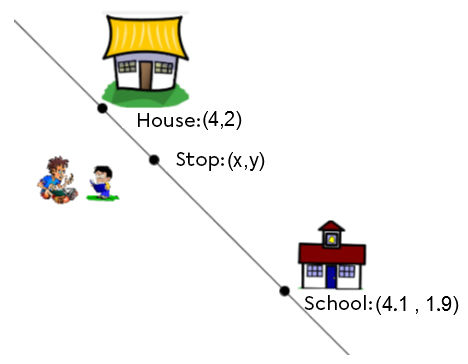
Using the given information, determine your bus stop’s coordinates.
-
Identify the starting point and the ending point. ||\begin{align} \text{House} &=(\color{blue}{x_1},\color{red}{y_1})= (\color{blue}{4},\color{red}{2}) \\ \text{School} &=(\color{green}{x_2},y_2)= (\color{green}{4{.}1},1{.}9) \end{align}||
-
Find the fraction |\dfrac{a}{b}| associated with the ratio. ||1:4=\dfrac{1}{1+4}=\dfrac{1}{5}||
-
Substitute the values into the formula and solve the equation to find the |x| coordinate of the division point. ||\begin{align} x &= \color{blue}{x_1}+\dfrac{a}{b}(\color{green}{x_2}-\color{blue}{x_1}) \\ x&= \color{blue}{4}+\dfrac{1}{5}(\color{green}{4{.}1}-\color{blue}{4}) \\ x &= 4{.}02 \end{align}||
-
Substitute the values into the formula and solve the equation to find the |y| coordinate of the division point. ||\begin{align} y &= \color{red}{y_1}+\dfrac{a}{b}(y_2-\color{red}{y_1}) \\ y&= \color{red}{2}+\dfrac{1}{5}(1{.}9-\color{red}{2}) \\ y &= 1{.}98 \end{align}||
Answer: The coordinates of the division point |(x,y)| is |(4{.}02,1{.}98).|
It is important to differentiate between the two types of notations that are used to illustrate the portions associated with a division point in order to use the appropriate notation for the formula: ||\begin{matrix}\text{Ratio} \\ \Large{a:b} \end{matrix} \Leftrightarrow\ \begin{matrix}\text{Fraction} \\ \large\frac{a}{a+b} \end{matrix}||
The lines |y_1 = a_1 x + b_1| and |y_2 = a_2 x + b_2| are parallel if and only if |a_1 = a_2.|
What is the equation of the line that is parallel to the one identified in the Cartesian plane below and that passes through point C?

|
CALCULATIONS |
EXPLANATIONS |
|---|---|
|
|a = \dfrac{\Delta y}{\Delta x} = \dfrac{0{.}7 - 2{.}5}{1{.}5 - 0} = -1{.}2| |
Find the slope of |\overline{AB}.| |
|
|\begin{align} y &= -1{.}2x + b \\ 2{.}25 &= -1{.}2 (1{.}55) + b \\ 2{.}25 &= -1{.}86 + b \\ 4{.}11 &= b \end{align}| |
Find the equation of the line passing through |C (1{.}55, 2{.}25)| in function form |y = ax + b.| |
|
The equation of the line that is parallel to |\overline{AB}| and passes through point | C (1{.}55, 2{.}25)| is |y = -1{.}2x + 4{.}11.| |
|
The lines |y_1 = a_1 x + b_1| and |y_2 = a_2 x + b_2| are perpendicular if and only if |a_1 \times a_2 = -1.|
We also say that two lines are perpendicular if the slope of one is the opposite of the reciprocal of the slope of the other: |a_2 = \dfrac{-1}{a_1}.|
What is the equation of the line that is perpendicular to the one identified in the Cartesian plane below and that passes through point C?
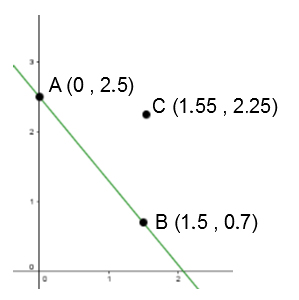
|
CALCULATIONS |
EXPLANATIONS |
|---|---|
|
|a_1 = \dfrac{\Delta y}{\Delta x} = \dfrac{0{.}7 - 2{.}5}{1{.}5 - 0} = -1{.}2| |
Find the slope of |\overline{AB}.| |
|
|\begin{align} a_1 \times a_2 &= -1 \\-1{.}2 \times a_2 &= -1 \\ a_2 &= \dfrac{-1}{-1{.}2} \\ a_2 &= 0{.}8\overline{3} \end{align}| |
Keeping in mind that the product of the slopes of two perpendicular lines is equal to |-1| , find the value of |a_2| of the line passing through C. |
|
|\begin{align} y &= a_2 x + b \\ y &= 0{.}8\overline{3}x + b \\ 2{.}25 &= 0{.}8\overline{3} (1{.}55) + b \\ 2{.}25 &\approx 1{.}29 + b \\ 0{.}96 &\approx b \end{align}| |
Find the rule of the line passing through |C (1{.}55, 2{.}25)| |
|
Finally, the equation of the line which is perpendicular to |\overline{AB}| and which passes through the point |C(1{.}55, 2{.}25)| is |y=0{.}8\overline{3}x + 0{.}96.| |
|
See also
|MD = \dfrac{\sum \mid x_i - \overline {x} \mid}{n}|
Where
|x_i| represents each data.
|\sum| represents the sum.
|n| represents the total number of data.
During the last month, 11 houses in the same neighbourhood were sold for the following prices:
|\color{blue}{\$156\ 700},| |\color{red}{\$158\ 900 },| |\$159\ 000\,| |\$162\ 500\,| |\$164\ 100,| |\$167\ 400,| |\$172\ 000,| |\$175\ 000,| |\$178\ 100,| |\$179\ 000,| |\$183\ 000.|
For statistical purposes for realtors, calculate the mean deviation of this distribution.
|
CALCULATIONS |
EXPLANATIONS |
|---|---|
|
|\dfrac{156\ 700 + 158\ 900 + \dots + 179\ 000 + 183\ 000}{11} = \color{green}{\$168\ 700}| |
Calculate the mean given by |\frac {\sum x_i}{n}.| |
|
|\begin{align} \mid \color{blue}{156\ 700} - \color{green}{168\ 700}{\mid} &= 12\ 000 \\ \mid \color{red}{158\ 900} - \color{green}{168\ 700}{\mid} &= 9\ 800 \\ \mid 159\ 000 - \color{green}{168\ 700}{\mid} &= 9\ 700 \\ \mid 162\ 500 - \color{green}{168\ 700}{\mid} &= 6\ 200 \\ \mid 164\ 100 - \color{green}{168\ 700}{\mid} &= 4\ 600 \\ \mid 167\ 400 - \color{green}{168\ 700}{\mid} &= 1\ 300 \\ \mid 172\ 000 - \color{green}{168\ 700}{\mid} &= 3\ 300 \\ \mid 175\ 000 - \color{green}{168\ 700}{\mid} &= 6\ 300 \\ \mid 178\ 100 - \color{green}{168\ 700}{\mid} &= 9\ 400 \\ \mid 179\ 000 - \color{green}{168\ 700}{\mid} &= 10\ 300 \\ \mid 183\ 000 - \color{green}{168\ 700}{\mid} &= 14\ 300 \end{align}| |
Calculate the deviations from the mean of each of the data. |
|
|MD = \dfrac{12\ 000+9\ 800+ \dots + 10\ 300 + 14\ 300}{11} \approx \$7\ 927{.}27| |
Calculate the average of the deviations from the mean (mean deviation). |
|R_{100}(x) = \displaystyle \frac{\text{number of data less than the value in question} + \frac{\text{number of equal data }}{2}}{\text{total number of data}} \times 100|
Note: We round up to the whole number if the answer is not a whole number.
Candidates must pass a written test before being hired to fill positions in the federal government’s public sector. Here is the list of results, in percentages, of the different candidates:

To ensure that they retain the best candidates, only those with a result higher than the |85^th| percentile rank will be retained. In light of this information, will your application be successful if you get a result of |84\ \%?|
|
CALCULATIONS |
EXPLANATIONS |
|---|---|
|
|R_{100}84 = \displaystyle \frac{\color{blue}{21} + \frac{\color{green}{3}}{2}}{\color{red}{33}} \times 100| |
Looking at the table, we find: ||\begin{align} \color{blue}{21} &\color{blue}{= \text{number of data less than the value in question}} \\ \color{green}{3} &\color{green}{= \text{number of data equal}} \\ \color{red}{33} &\color{red}{= \text{total number of date}} \end{align}|| |
|
|R_{100}84 \approx 68{.}18| |
This result was found using the order of operations. |
|
|R_{100}84 = 69| |
If the answer is not a whole number, the percentile rank always corresponds to the next whole number (round up). |
|
Despite your result of |84\ \%,| your application will not be kept for the rest of the process , because you have a percentile rank of |69.| |
|
See also
|\text{Position of the data } = \dfrac{\text{percentile rank}}{100} \times \text{total number of data}|
Note: Round down if the answer is not a whole number.
Candidates must complete a written test before being hired to fill positions in the federal public sector. Here is the list of results, in percentages, of the different candidates:

To ensure that you keep the best candidates, only those with a result higher than the |82^nd| percentile rank will be retained. In light of this information, starting from which test result will the candidates be selected?
|
CALCULATIONS |
EXPLANATIONS |
|---|---|
|
|\begin{align} \text{Percentile Rank of the data} &= \frac{\color{blue}{82}}{100} \times \color{red}{33} \\ &\approx 27{.}06\end{align}| |
According to the data from the question, we get: |
|
|\text{Position of the data} = 27| |
The position of the data always corresponds to the lower integer if the answer is not a whole number. |
|
Since the data located at the |27^{th}| position is |92|, everyone who received a result greater than |92\ \%| will be retained. |
|
The scatter plot is used to estimate the correlation between two variables. The correlation coefficient must be calculated to get a more precise idea of the correlation.

A new company has increased its profits for five years and seeks to expand its production centre. However, the owners want to ensure that the economic growth of their company is positive and strongly correlated. To break it all down, here's a count of business income for the past 30 weeks.

In your opinion, is the economic growth of the company positive and strongly correlated?
-
Construct the scatter plot

-
Compare the scatter plot to those that serve as a reference
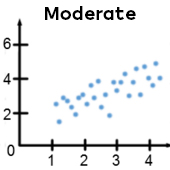
Answer: According to the scatter plot, it can be concluded that the incomes are positive and moderately correlated. Since they are not strongly correlated, it would be best to wait before expanding.
After framing the scatter plot and measuring the length |(L)| and width |(l)| of the rectangle:
||r = \pm \left(1 - \dfrac{l}{L}\right)|| The sign depends on the direction of the scatter plot (whether it is increasing or decreasing).
This coefficient can also be used to qualify the correlation:
| Value |r| | Linear correlation strength |
|---|---|
| Near |0| | >Zero |
| Near |\pm 0{.}50| | Weak |
| Near |\pm 0{.}75| | Moderate |
| >Near |\pm 0{.}87| | Strong |
| Near |\pm 1| | Very strong |
| |\pm 1| | Perfect |
To take stock of the success of students who enroll in adult education institutions, the administration team is studying the correlation between absenteeism (in hours) and students’ final grades (in %). They grouped the data into a scatter plot to properly analyze the situation:
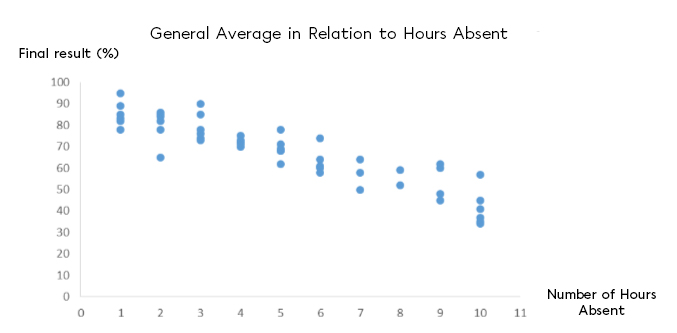
What is the correlation coefficient of this study?
|
CALCULATIONS |
EXPLANATIONS |
|---|---|
 |
Draw a rectangle, as small as possible, to frame the scatter plot. |
| |
Using a ruler, measure the length |(L)| and width |(l)| of the rectangle. In this case, |
|
|\begin{align} r &\approx \pm \left(1 - \dfrac{\color{red}{2{.}8}}{\color{blue}{13{.}5}}\right) \\ r &\approx \pm 0{.}79 \end{align}| |
Replace |L| and |l| in the formula |r \approx \pm \left(1 - \frac{\color{red}{l}}{\color{blue}{L}}\right).| |
|
|r \approx - 0{.}79| |
Since the rectangle is oriented downwards (decreasing), the correlation coefficient is negative. |
|
The correlation coefficient between the number of hours absent and the final result in percentage is approximately |-0{.}79,| which means it is a moderate negative correlation. |
|
See also
Follow these steps to find the equation of the regression line according to the Median-Median method:
-
Put the points in ascending order according to the value of |x.|
-
Divide the pairs into three equal groups, if possible.
-
Calculate the median coordinates |(M_1, M_2, M_3)| of each group.
-
Calculate the mean coordinates |(P_1)| of the three midpoints.
-
Calculate the value of the slope |(a)| with |M_1| and |M_3.|
-
Calculate the value of the initial value |(b)| using |P_1.|
-
Write the equation of the regression line in the form |y = ax + b.|
Before building a new condo tower and doing the landscaping, the heights of the surrounding trees are measured to ensure they do not obscure the view for at least the next 20 years. To estimate the height the balconies should be, the following table of values is used:

Using this information, determine how high the first balconies should be so that their view is not obstructed by trees.
|
CALCULATIONS |
EXPLANATIONS |
|---|---|
 |
Place the points in ascending order according to the value of the independent variable |(x)|, taking care not to “undo” the initial ordered pairs. |
 |
Separate the points into three equal groups. If this is not possible, make sure that the first and the last group have the same amount of data. |
|
|M_1 = (1, 29)| |M_3 = (4, 90)| |
Calculate the median coordinate of each group. |
|
|\begin{align} \color{green}{P} &= \left(\frac{1 + 2{.}5 + 4}{3} , \frac{29 + 56 + 90}{3}\right) \\ &= \color{green}{(2{.}5 , 58{.}33)} \end{align}| |
Calculate the mean point by taking the average of the |x|’s and |y|’s of the three midpoints. |
|
|\color{blue}{a} = \dfrac{\Delta y}{\Delta x} = \dfrac{90 - 29}{4 - 1} \approx 20{.}33| |
According to the equation of the regression line |y = \color{blue}{a}x + \color{red}{b}|, determine the value of |\color{blue}{a}| from the points |M_1| and |M_3.| |
|
|\begin{align} y &= \color{blue}{20{.}33} x + \color{red}{b}\\ \color{green}{58{.}33} &= \color{blue}{20{.}33}(\color{green}{2{.}5}) + \color{red}{b} \\ \color{red}{7{.}503} &= \color{red}{b} \end{align}| |
Find the value of parameter |\color{red}{b}| by substituting |x| and |y| with the coordinates of the point |\color{green}{P}.| |
|
|\begin{align} y &= \color{blue}{20{.}33} x + \color{red}{7{.}503} \\ y &= \color{blue}{20{.}33} (20) + \color{red}{7{.}503} \\ y &= 414{.}103 \end{align}| |
Since we want to know the height of the trees after |20| years, substitute |x| with |20.| |
|
After |20| years, the trees will be about |414{.}103\ \text{cm}.| Thus, the first balconies must have a minimum height of |414{.}103\ \text{cm}.| |
|
Even though the situation and data are the same, it is normal that the final answer varies depending on the method used (Median-Median method or Mayer method).
Since these methods are used to estimate and not to predict outcomes with certainty, there may be a difference between the two outcomes.
See also
Follow these steps to find the equation of the regression line according to Mayer’s method:
-
Put the points in ascending order according to the value of |x.|
-
If possible, divide the pairs into two equal groups.
-
Calculate the mean points |(P_1| and |P_2)| of each group.
-
Use these mean points to find the value of the slope |(a)| and the initial value |(b).|
-
Write the equation of the regression line in the form |y = ax + b.|
Before building a new condo tower and doing the landscaping, the heights of the surrounding trees are measured to ensure they do not obscure the view for at least the next 20 years. To estimate the height that the balconies should be, the following table of values is used:

Using this information, determine how high the first balconies should be so that the view is not obstructed by trees.
|
CALCULATIONS |
EXPLANATIONS |
|---|---|
 |
First, place the points in ascending order according to the value of the independent variable, without undoing the initial ordered pairs. |
 |
If possible, separate the distribution into two equal groups. |
|
|\begin{align} P_1 &= \left(\dfrac{\color{red}{1+1+... +2+2}}{7}, \dfrac{\color{blue}{21+23+...+42+54}}{7}\right) \\ &\approx (\color{red}{1{.}43}, \color{blue}{34{.}29}) \\\\ P_2 &= \left(\dfrac{\color{green}{3+3...+4+4}}{7}, \dfrac{58+59+...+90+97}{7}\right) \\ &\approx (\color{green}{3{.}43},; 76) \end{align}| |
Calculate the mean points of each of the groups. |
|
|a = \dfrac{\Delta y}{\Delta x} = \dfrac{76 - \color{blue}{34{.}29}}{\color{green}{3{.}43} - \color{red}{1{.}43}} \approx 20{.}86| Thereby, |y = 20{.}86x + b.| Thereby, |y = 20{.}86x + 4{.}46.| |
Find the equation of the regression line in the form |y = ax + b| according to the points |P_1| and |P_2.| |
|
|\begin{align} y &= 20{.}86x + 4{.}46 \\ y &= 20{.}86 (20) +4{.}46 \\ y &= 417{.}2 + 4{.}46 \\ y &= 421{.}66 \end{align}| |
Since we want to know the height of the trees after |20| years, substitute |x| with |20.| |
|
After |20| years, the trees will be about |421{.}66\ \text{cm}.| Thus, the first balconies must be of a minimum height of |421{.}66\ \text{cm}.| |
|
Although the situation and data are the same, it is normal that the final answer varies depending on the method used (Median-Median method or Mayer method).
Since these methods are used to estimate and not to predict outcomes with certainty, there may be a difference between the two outcomes.
